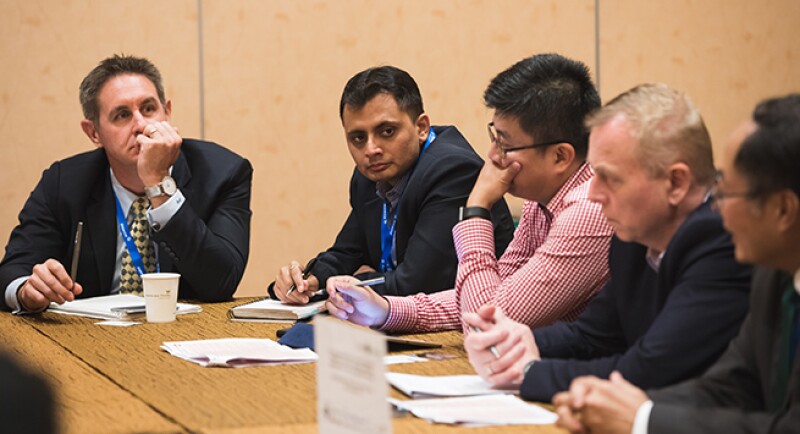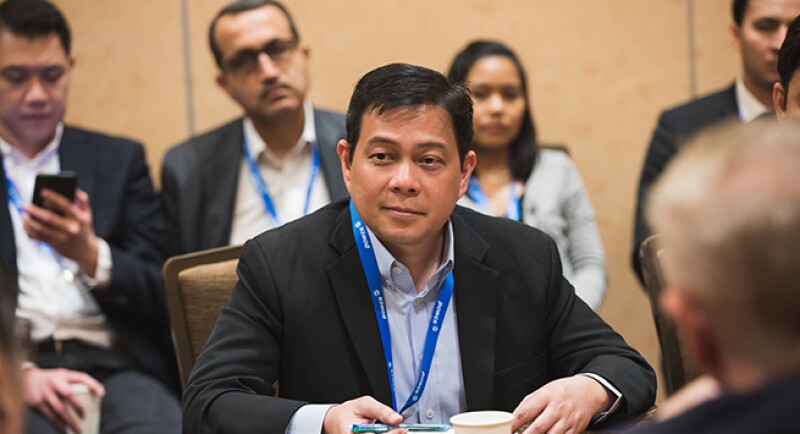In late 2017, the Philippines stole the tower industry spotlight when President Rodrigo Duterte announced his intention of developing a Common Tower Policy for the country. Last September, his collaborator and advisor Ramon Jacinto presented the first policy draft in front of key national and regional industry stakeholders. Finally, last November, the Department of Information and Communications Technology (DICT) appointed Mislatel as the new third operator to challenge Globe and Smart’s duopoly, making the business case for towercos even more compelling. ISOC Infrastructures, a local business conglomerate engaged in cold chain logistics, property and energy development, is one of the 12 telecom infrastructure companies that have signed an MoUs with the Department of Information and Communications Technology (DICT) aiming to obtain a towerco license to operate in this market.
During the last TowerXchange Meetup Asia, several senior ISOC representatives came together to host a roundtable, which analysed how the irruption of a third operator will drive infrastructure deployment in the Philippines and how the government has created the necessary regulatory environment to catch the attention of edotco, American Tower and several other prospective investors in the country.
Mislatel and the urgency of tower deployment
On November 7th, DICT selected Mislatel, a consortium led by local businessman Dennis A. Uy and state-owned China Telecom Corp, as the Philippines’ provisional third operator. Eliseo Rio, DICT Acting Secretary, declared that the company was the only bidder able to match selection requirements, while The Philippine Telephone & Telegraph Corp. and Sear Telecom Consortium were disqualified as they failed to submit participation security and technical capability certification.
Mislatel committed to provide 37% coverage at an average internet speed of 27Mbps in its first year, with an initial investment of more than US$2.5 bn. The company will have to cover 84% of the total Philippine population with an average internet speed of 55Mbps, which will require a total investment of US$4.88bn within five years.
The telco is expected to obtain the necessary certification and frequencies to operate soon and will have five years to roll out its infrastructure. DICT requires the company to begin operations within one year after final award. Therefore, by the end of this year or early 2020 at the latest, Mislatel will require equipment on a decent number of towers to be up and running if they don’t want to face the financial penalties set by the local government. Based on current numbers of towers owned by the operators and local experts’ estimations, the new operator will require at least 9,000 new sites to be on a par with the incumbents.

Understanding the Philippines regulatory regime
At the beginning of the conversation, ISOC dissected the most relevant aspects of the initial draft tower policy that has been under public consultation since it first became public in September. MNOs won’t be able to own or build towers directly. Towercos will have to be independent—so MNOs cannot own a stake on those companies—and this initial draft limits the number of towercos to a maximum of two. Additionally, operators will have to share their rollout plans with the tower companies in advance.
Based on those premises, ISOC was the first company that submitted an unsolicited proposal back in July. After that initial overview, the discussion began, and questions started to cross the room.
Does it make sense to limit the number of towercos in such a big, diverse country?
Experienced tower developers, consultants and most industry experts agreed that a country like the Philippines, comprising of 7,000+ islands and an estimated population of 104mn+, would need at least two tower companies to deliver the necessary infrastructure to meet the current demand and industry requirements.
Some participants mentioned that is very likely that we see several propositions from both local and international players. “Capacity to build is going to be a major issue and building cycles are going to be quite long. Even if you get the biggest constructor in the world, the Philippines is a tough logistical environment, so developing the necessary number of sites might require participation from more than two companies,” one of the participants stated.
Two months after this conversation took place, DICT had signed MOUs with 12 tower providers and the limitation to two tower providers that appeared on the first policy draft might not apply.
Will Globe and Smart be forced to release their assets?
Under the draft policy, operators will not be required to sell their existing assets. The draft policy does encourage tower sharing, although Globe has publicly expressed its interest to sell, however, this won’t be an obligation. In other markets, market forces have driven operators to sell or share their tower assets.
Can foreign players enter the tower market?
Some industries have certain ownership limitations in the Philippines. Emerging tower companies will be considered construction businesses, and construction is one of the sectors where foreign ownership is limited by law, hence 60% of any emerging towercos would have to be owned by a local company. International infrastructure players are more than welcome into the Philippines, but entering the market requires a local partner. In the mid-term, infrastructure assets could potentially sit within a 100% foreign-owned company, but the towers have to be built by a company with a minimum of 60% local participation. Currently, this is one of the main points under debate, as deploying such a large number of towers would require significant capex, scale and expertise which might be difficult to source locally.
However, that handicap could be turned into an advantage and having a local partner might end up helping international players to enter the market by deploying local investment, boosting social license and facilitating engagement with key, local industry stakeholders.
Potential candidates
12 aspiring infrastructure providers have now signed MOUs with the Department of Information and Communications Technology, and another local company is expected to join the list below:
ISOC Infrastructures Inc.
iSON ECP Tower Singapore Pte. Ltd.
edotco Group Sdn Bhd
RT Telecom Sdn Bhd
IHS Towers
China Energy Equipment Co. Ltd.
Aboitiz InfraCapital Inc.
MGS Construction Inc.
American Tower Corp.
Frontier Tower Associates Management
Phil Tower Consortium (Global Networks Inc. and JTower Inc.)
JS Cruz Construction and Development Inc.
Under the MOUs, the enterprises are mandated to secure a business contract from the MNOs before DICT starts providing assistance and facilitating permits, right of way and other licenses for infrastructure deployment, while DICT aims to publish the final common tower policy by the second quarter of this year.
Exploring different scenarios and risks: What happens if Globe does not sell?
Currently, the draft policy does not force operators to sell their towers and some experts question whether Mislatel could really enter the market if one of the operators does not release their assets. Most roundtable participants agreed on one sentiment: nobody has the capacity to build 9,000 new towers in two years. With that in mind, the ideal scenario would have Globe (and even Smart) selling their tower portfolios to one or two neutral players who would manage them independently and provide access to all three operators. The draft policy requiring that MNOs do not retain equity in towercos would seem to preclude any option for Globe (or Smart) to carve-out and keep a controlling stake their own towercos. If an independent towerco were not to acquire the legacy tower in The Philippines, the emerging towercos would have to build at least 4,500 towers in the first year, which seems to be almost an impossible mission, at least in eyes of the experts that joined the roundtable. Failing would also generate considerable penalties for the new operator.
On the other hand, even acquiring Globe’s assets would have some risks, as the structural capacity of the towers still needs to be evaluated to ensure they can handle two or three tenants.
Finally, the government has been the main driver for this initiative, as such, any political shift in the country could curtail or reshape this process, and those are all risks factor that any emerging company would have to take into account.

How is the government creating opportunities for the industry?
The government is aware of the risks mentioned above and has been proactive in creating guarantees and a favourable regulatory environment for the industry.
During the third MNO selection process, President Rodrigo Duterte himself rushed DICT to appoint an operator, stating that he would hand pick one of the candidates if the institution does not. ISOC highlighted the proactive role of the executive and its positive outcome as Duterte didn’t hesitate to step in when it was necessary. “The government has taken all the necessary steps. Duterte’s team has promoted competition in the market by favouring the creation of a third operator, and now is introducing a positive legislation as a necessary and initial move to drive telecoms infrastructure sharing in the country.”
The draft policy recognised the negative impact of barriers that slow permitting and that is, based on ISOC testimony, one of the key developments on the law. “Regulators have included certain previsions that will help speed up permitting. They are opening a national single one stop shop for tower permits and they have hinted at the possibility of sharing government sites to tower companies, again to accelerate the site acquisition and permitting process.” Any meaningful progress on accelerating permitting could make Philippine towers relatively investible as in neighbouring countries such Sri Lanka, you need around six months to get private land access, while government land access permission could take up to a year.
A few more critical points were also addressed throughout the discussion including a potential timeline for the policy to be finalised and made official, and the investment climate in the Philippines. ISOC estimates that a final policy could be released during the first quarter of 2019 and also weighed on the cost of investment in the country: “Capital cost in the Philippines is pretty much comparable to the rest of Southeast Asia, but there have been some recent fluctuations. It has gone up this year due to the inflationary effects of new tax rules but it should go down again in 2019, which could be another incentive for international companies to enter the market.”
Why could the Philippines be the perfect match for a global player?
First, the need is there for a global towerco in the Philippines. The irruption of a third operator will massively drive infrastructure deployment, as we have recently seen in Myanmar with fourth operator Mytel. Globe and PLDT are two very strong, established customers and adding just one of them to a towerco’s portfolio through co-locations would represent a very bankable revenue stream.
An emerging new player in the country would also be in an advantageous position when negotiating contract conditions with Mislatel, who will imminently require an enormous number of new towers or co-locations. Both demand and urgency are there, but a smart tower company should be able to negotiate and manage expectations to avoid over commitments. Mislatel needs to work closely with an external partner for their rollout. There are risks for potential towercos, but that risk should be taken into account and priced in as part of the negotiation.

